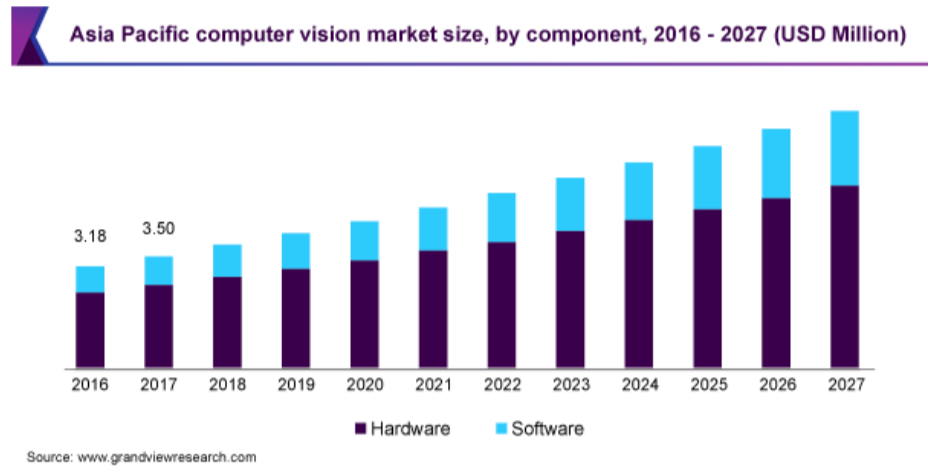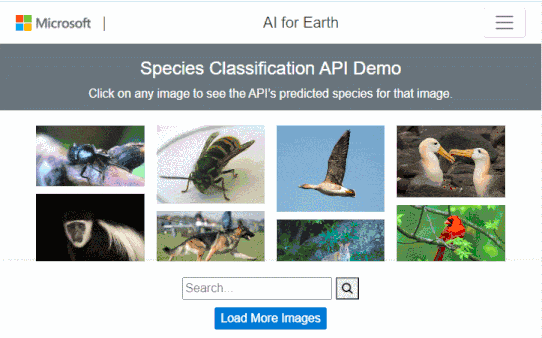Computer vision is not an early advancement in the field of technology. In fact, the first computer vision application was launched in the 1970s to distinguish between handwritten text and printed copy. Now, computer vision is a prime integration in multiple domains such as automotive, biodiversity conservation, and retail quality checks. Let’s look at some of the important computer vision examples that are making business processes and everyday tasks easy.
Table of Contents

What is Computer Vision?
Computer Vision is an Artificial Intelligence (AI) field that uses Deep Learning models to train computers and systems to understand visual images and cues, enabling computers to “see” objects and react accordingly. Computers are trained to see just the way humans do; however, humans have a vast memory of objects they have seen through their lifetimes. Computers learn the same through camera images, videos, and algorithms.
Computers are machines and once they have recognized an image, say of a product, they can analyze hundreds, even thousands of products in a minute. They can do the same for several processes, benefitting organizations to scale their processes. The capabilities are used in wide-ranging industries such as banking, energy, manufacturing, life sciences, automotive, utilities, etc.
Computer Vision Technology Market Size

The computer vision technology market was sized at USD 10.6 billion in 2019 and pegged to grow at a CAGR of 7.6% from 2020 to 2027 as per a Grand View Research report of September 2020.
And while the Covid-19 scourge ravaged businesses through 2020 and most of 2021, it also spurred the tech giants to create solutions to prevent, mitigate and contain the virus. Solutions such as chest Computed Tomography (CT) scan to detect coronavirus patients, Human Presence System to remotely monitor patients, and Face Mask Detection System to detect people not wearing masks are helping in the control of this outbreak.
Where Computer Vision Technology is Implemented
The technology is used for a variety of purposes by businesses across the board. Some of them are:
- Surveillance
- Motion capture
- Machine inspection
- Retail
- Medical imaging
- Automotive safety
- Optical character recognition (OCR)
- Biometrics
The automotive industry, especially makers such as Tesla, Volvo, BMW, and Audi, use computer vision in their self-driving cars. Computer vision enables these self-driven vehicles to spot objects, identify lane markings, and understand traffic signals for safe driving.
Healthcare is a significant segment of computer vision technology. The technology is helping in developing new medical diagnostic methods, monitoring patients (even remotely), and even assisting in surgery.
In sports, computer vision technology supports player ratings, ball, and puck tracking, sponsor visibility tracking in sports broadcasts, and play analysis and strategy. These are only some examples that show the diverse use of and challenges tackled by computer vision technology.
How Does Computer Vision Work?
Helping computers “see” is no easy job. It requires tons of data, lots of images, and multiple analyses to distinguish and recognize them. Deep Learning and Convolutional Neural Networks (CNN) are the two technologies used to accomplish this purpose.
First, a specific set of data is used to train the machine. The dataset is prepared so that it contains the images associated with the topic and those that are not. The images are tagged with metadata for the correct answer. The CNN analyzes the images several times as per metadata feedback, and thus, the machine learns to identify the right images through pattern recognition.
Gramener partnered with Microsoft AI to accurately perform the Species identification of Salmon fish in the Nisqually River. The Microsoft Visual Object Tagging Tool (VOTT) helped automate the identification and tagging of fish after processing the videos.
YOLO V3 was used in real-time video object detection, and it enhanced the solution speed. Thus, bio-scientists and experts can now analyze video reviews through this AI-based web solution instead of manual video reviews.
This solution will save both time and cost for the clients. It also shows how such computer vision solutions can help even in tricky situations such as this.
How Computer Vision Solves Business Challenges for B2B & Startups
The increased adoption of AI-based computer vision applications shows the current and future trends. Businesses are already looking to technology to solve their challenges.
Process automation, vision-guided robotic systems, hybrid and electric cars, and optimistic government initiatives are some of the things fueling the growth of the computer vision market. And computer vision technology is playing an essential role in the environment, healthcare, business, governance, transportation, entertainment, and other areas.
Computer vision helps businesses where they need :
- Better real-time responses
- Understanding facial and eye expressions
- Demand inspection services
- Recognize level surfaces or changes in light conditions
- Safer driving solutions
The Gramener Salmon fish detection AI solution is an example of better real-time responses solving a business challenge by improving efficiency and speed.
Google ArCore is a computer vision solution for recognizing primary climate conditions such as level surfaces and light conditions.
An emotion AI startup from London recognized people’s facial expressions as they saw advertisements through their computer or mobile camera. This helped big brands such as Coca-Cola, AT & T, and Mars to identify people’s expressions before rating a commercial for attention and emotion.
Computer vision technologies are finding increased use because of a plethora of visual information from smartphones, traffic cameras, security cameras, etc.
Since machines can increase the efficiency, the computer vision market has seen investments to the tune of $120 million in North America and $3.9 billion in China.
AI Driven Best Computer Vision Examples Across Industries
There are a large number of examples of computer vision in diverse fields. Let us have a look:
Automated Cell Counting for Pharma

Counting biological cells through a microscope is a painstaking process. The challenge is significant because biological cells don’t have perfect shapes. Moreover, the microscopic images have extra portions that don’t come in the count.
But we tacked this challenge by transforming a crowd counting model into an AI-driven automated cell counting solution. The solution used outlier detection to exclude the extra portions.
It also used Contour detection to identify the cells counted by the model and to put them on a UI for manual inspection.
This solution is especially useful in drug characterization in pharma drug discovery.
Retail and Inventory Management
Computer vision technology has brought emotional AI to the fore. Their smartphone or laptop camera captures people’s facial expressions and eye movements during video calls or facial logins.
Companies use this information with the consent of people to train their AI models to understand emotions. With sentiment analysis for ads, sales and marketing teams can create targeted ad campaigns.
Similarly, at retail outlets, customer emotion analytics can give insight into product performance. Computer vision applications on shelves can also help keep real-time track of inventory.
Crop Yield and Protection
Who would have thought that computers would improve crop yield? But AI and computer vision are making this possible.
Agritech companies and smart farming enablers are using computer vision to identify weeds in crop fields and spray herbicides directly on them instead of the crops. This will not just reduce the need for herbicides but also minimize crop damage caused by weeds and excess herbicides. In turn, crop yield is likely to improve.
Computer vision applications are improving gradually to tackle more challenges such as detecting the grain quality at the time of harvest. It also helps to identify the best route through the crops. This can potentially prevent crops from trampling.
Disaster Relief and Recovery
While we can’t prevent natural disasters, we can predict them with deep learning and computer vision. This can save lives. Data from seismic sensors, radar maps, wildfire sensors, and flood sensors already exists. You can integrate these sensors with computer vision to get pre-warnings. This allows some time for people to shift to safety. Drones and robots with computer vision can identify disaster survivors and drop humanitarian aid.
Automotive and Vehicle Management
Driverless cars are the focus of the automotive industry for a while now. These cars rely heavily on computer vision to identify all the objects in their surroundings. They gather data from cameras to know what surrounds them and react accordingly. Computer vision algorithms help these cars in understanding driving scenes, controlling motion, and planning the path.
Assume an insured car is involved in an accident. The user reports that an accident occurred with the insurance company. Traditionally, this is followed by a manual examination by the insurance company to determine the extent of the damage and confirm the legitimacy of the claim.
However, we can automate vehicle damage detection with the help of Artificial Intelligence and Computer Vision.
Banking and Security
The Covid-19 pandemic may have stalled the economy for a while, but technology is helping get it back on track. This is especially true in the case of the banking industry, where an increasing number of banks are allowing users to open accounts using verification through facial recognition.
Similarly, image processing techniques can be put to use for depositing cheques by simply submitting the front and back picture of the cheque. Face recognition technology is also used in other industries for security purposes.
Predictive Maintenance in Manufacturing
Manufacturers can optimize and scale their processes using computer vision applications and AI. One such use is predictive maintenance. Computer vision can help monitor the equipment regularly and raise timely alarms to prevent breakdowns. Manufacturers can also keep tabs on product quality and packaging. In this way, they can reduce the number of faulty products.
Computer Vision in Education
Teachers can monitor and understand the behavior and attitudes of students through AI-enabled cameras. Through this understanding, they can ramp up their teaching methods and provide personalized solutions to their students.
Waste Management
Waste recognition technologies help in sorting waste in bins, trucks, and waste facilities. Even smart bins are facilitating the automated sorting of waste. Thus, increasing waste management and recycling efficiency.
Computer vision is still a nascent technology, but it already offers solutions to various business and consumer challenges. In the future, the human-machine partnership will create greater scalability and enhanced innovation. Several challenges that may seem daunting now will be tackled with ease in the future because of computer vision technologies.
Animal Counting and Species Detection
We should conserve the species that are going extinct. However, manually sighting and counting animals of a particular species is a huge task. Gramener has partnered with Microsoft AI for Earth to provide a computer vision solution for counting penguins. The Antarctic ecosystem is at risk, and so are the species inhabiting it, including the penguins.
The Gramener solution comes in its wake. The University of Oxford set up Camera trap systems to take time-lapse pictures of the Antarctic region. These systems produce millions of images. We used these pictures to train the deep learning networks and the AI.
For training the software, the Gramener team used crowdsourced images with metadata. However, while the AI solution was great, it was expensive. Hence, Gramener partnered with Intel to bring down the hardware and computing cost.
This optimized solution delivered 2.5 times better performance and increased the accuracy of counting penguins. The solution can help scientists and researchers in conservation efforts for penguins.
Enhancing Environmental Sustainability

Gramener has developed a species detection AI solution with Microsoft AI for Earth. The solution uses Camera Trap Image Processing to segregate images into four categories – human, animal, vehicle, and empty. With the classification of over 5000 plant and animal species, this solution is not just helping in species identification but also environmental sustainability.
Contact us for custom built low code computer vision solutions for your business challenges and check out ESG and AI solutions built for our clients, including Fortune 500 companies. Book a free demo right now.

